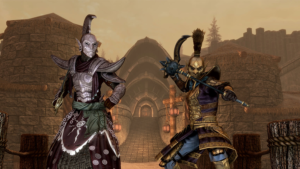Sword and Fairy is a franchise that may not be well-known outside of the East, but it is a long-running beloved and notable series that has only finally made its way west in recent years. While many of them are well-received and technically available to play, most are only in Chinese, requiring fan translations for Western gamers to be able to experience them. Sword and Fairy: Together Forever (aka Sword and Fairy 7) is making a jump to try and be a better-recognized Eastern Action-RPG series. After playing the first two hours on PlayStation 5, Sword and Fairy did take my interest as a game I want to see through to the end, despite its obvious shortcomings.
The very first thing worth mentioning is that while this is a western localization, the entire game is spoken in Chinese. There are subtitles for dialogue, but even so I did have some issues at times. When dialogue would advance on its own there were instances when I wasn’t able to finish reading it in time. I also noticed grammatical errors every now and then. To a certain degree, I can appreciate the authenticity that is being presented, but this may cause a real fundamental problem for some players.
Although it is an ongoing series, Sword and Fairy: Together Forever serves as its own self-contained story, so for those who want to give it a try, there is no required knowledge needed to fully enjoy what is offered. The story revolves around a young woman named Qingshu, a practitioner of the sword who helps protect her local village from monsters. It isn’t until she rescues a mysterious boy that she is flung into an ongoing war between deities and demons…naturally.
“
This may be a somewhat stereotypyical concept for those familiar with the JRPG genre, but it’s the story that has ultimately drawn me in. It is also rare for western audiences to get an Action-RPG with JRPG elements that focus so heavily around Chinese culture, thus making it feel like a fresh experience even when in other instances Sword and Fairy struggles.
Graphically, Sword and Fairy is a big step up from its previous entry visually. Running on Unreal Engine 4, it is filled to the brim with gorgeous character models, creatures, environments, and architecture on PS5. However, it is not consistent outside of cutscenes. Nevertheless, there was more than one moment throughout my playtime where I took pause to appreciate the areas surrounding me.
The gameplay, on the other hand, is where Sword and Fairy is a bit lacking in the first two hours. Taking place primarily in a mountainous terrain, Sword and Fairy is split into different areas. During specific sections of the story there will be side quests available. Sadly though, the ones I tried serve as nothing more than your typical fetch quest.
Similarly, combat also fails to reach the potential it could have, at least so far. Taking place in real-time hack ‘n slash fashion, a first for the series, you have a few combos here and there, but it never felt tight – even with a lock-on feature. Part of this is due to a lack of flow in combat, but another source of frustration both in and out of battle was the camera. I found it continuously getting lost on me, and even after lowering its sensitivity in the Settings menu I still found problems regularly.
“
Characters are equipped with their own unique abilities like shooting spectral swords, striking down enemies with lightning, or even just general healing – but it could all have been incorporated better. Abilities can’t be activated until your character is done with the move they are currently doing, meaning you cannot cancel into other moves. When it comes to boss battles I did find a little bit more fun by using the environment as a strategic tool to gain an advantage as well as the divisive mechanic that is quick time events, but generally it is more flash over substance.
After my time with Sword and Fairy: Together Forever, it has earned a deeper dive from me despite its flaws. Being most comparable to JRPGs, it made a good impression with its story and presentation immediately giving several unexpected twists in such a short time, even if the gameplay has been middling. All of the characters that I’ve been introduced to have promise, and there are questions the game asks that I want to know the answers to. After playing the first two hours, I suspect that Sword and Fairy will not be for everyone. However, for those willing to give it a chance, I think you may come out surprised by the intimacy and charm that the plot and world brings when the full game releases on PlayStation platforms in August.



